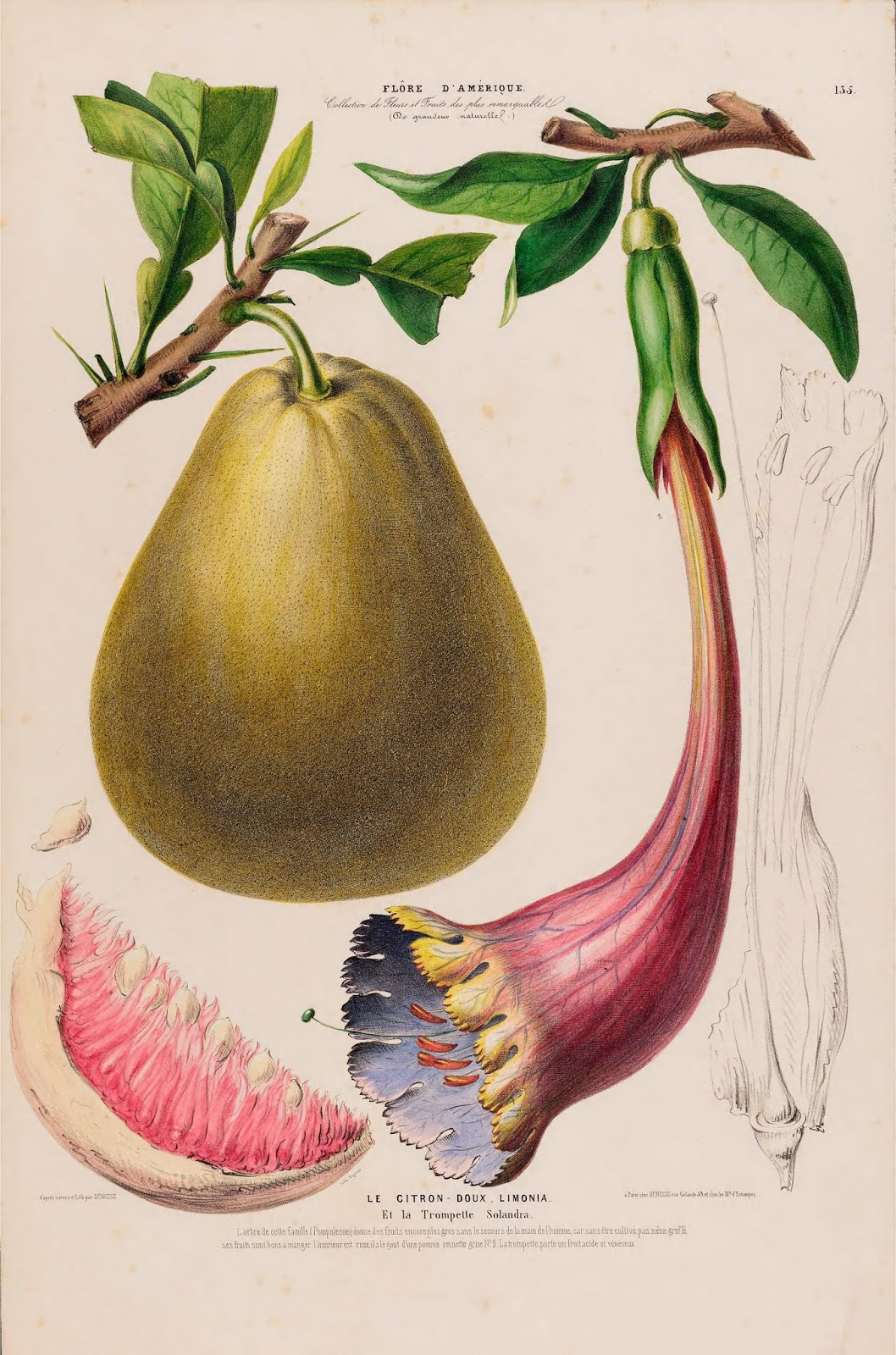Flore d’Amérique: Illustrating America’s Tropical Flora
 |
| Denisse, Etienne. Flore d’Amérique. 1843-46. Digitized by the LuEsther T. Mertz Library at The New York Botanical Garden. http://s.si.edu/2Ac5T4m. |
In the 1840s, Europe was enraptured by the beauty of America’s tropical flora. With the production of the lavishly-illustrated Flore d’Amérique (1843-46), Etienne Denisse brought the exotic flowers, fruits, trees, vines, and nuts growing in the Caribbean Islands to captivated readers across the Atlantic.
As a lithographer for the French royal court, Etienne Denisse spent his early career at the botanical garden of the Muséum National d’Histoire Naturelle in Paris, but employment by the government took Denisse’s work to the New World. He spent many years in the French West Indies, illustrating and collecting plants from the region and sending specimens back to France [4] [2].
 |
| Denisse, Etienne. Denisse, Etienne. Flore d’Amérique. 1843-46. Digitized by the LuEsther T. Mertz Library at The New York Botanical Garden. http://s.si.edu/2iXrY2J. |
Denisse’s work in America culminated in the production of the magnificent Flore d’Amérique, comprised of a total of 201 plates. This title is very rare, and copies are often incomplete. However, thanks to the LuEsther T. Mertz Library at The New York Botanical Garden, anyone in the world can freely access Denisse’s masterpiece through the Biodiversity Heritage Library.
Flore d’Amérique’s stunning hand-colored lithographic plates were based on drawings “from nature” by Denisse. The work was issued in fascicles of six plates between 1843-1846 [2]. Imprints on the individual plates credit both the Parisian firm Gihaut Frères (plates 1-49,64-72) and Denisse (plates 50-63, 73-200) as publishers.
 |
| Denisse, Etienne. Denisse, Etienne. Flore d’Amérique. 1843-46. Digitized by the LuEsther T. Mertz Library at The New York Botanical Garden. http://s.si.edu/2hxKkUk. |
Originally founded by Antoine François Gihaut as a firm of printsellers, Gihaut Frères expanded into publishing after Gihaut’s sons, Jean François and Michel Ange, took charge of the operation in 1822. In 1829, the firm received a brevet to serve as lithographic printers, but after 1839, this work was contracted out to other lithographic printing houses [1]. A variety of lithographic printers are credited via imprints throughout the plates within Flore d’Amérique, including d’Aubert & C.ie, Laujol, Kaeppelin & C.ie, Vayron, and Becquet.
In 2007, The New York Botanical Garden, LuEsther T. Mertz Library opened an exhibition celebrating the Caribbean’s history, culture, and biodiversity. Entitled Paradise in Print, the exhibition showcased the rich flora of the region through the display of printed folio editions, rare books, and original watercolors from the Library’s collection [3].
 |
| Denisse, Etienne. Denisse, Etienne. Flore d’Amérique. 1843-46. Digitized by the LuEsther T. Mertz Library at The New York Botanical Garden. http://s.si.edu/2ipbuMS. |
Fittingly, Denisse’s Flore d’Amérique was among the treasures displayed as part of the exhibition. Through the printed page, Denisse and his fellow European explorers introduced the wonders of the New World to a broader audience across the Atlantic. Today, these illustrated publications are both works of art and valuable historical records that help provide insight into the ways in which European contact with America impacted the region’s biodiversity and culture.
View all of the illustrations from Flore d’Amérique in the BHL Flickr.
References
[1] British Museum. 2017. “Gihaut Frères (Biographical details).” Research. Accessed September 14, 2017. http://www.britishmuseum.org/research/search_the_collection_database/term_details.aspx?bioId=123627.[2] Christie’s Auction House. 2014. “Denisse, Etienne.” Sale 3400, December 4. Accessed September 14, 2017. http://www.christies.com/lotfinder/Lot/denisse-etienne-fl-1814-1857-flore-damerique-dessinee-5855859-details.aspx/.
[3] Dorfman, Jane, Marie Long and Stephen Sinon. 2007. Paradise in Print: Exhibition Catalog. Bronx: The New York Botanical Garden.
[4] Mullarkey, Maureen. 2007. “Botanical Eden.” The New York Sun, August 2.





Leave a Comment